There’s an old truism in cycling: the strongest rider always wins the Tour de France.
Well, almost always.
Over three weeks and 21 stages, the gaps that separate glory from heartbreak can be cruelly thin. It’s a battle of attrition, luck, minds and bodies, but also bikes.
And sometimes, it’s the machine — both good and bad — that can make the winning difference.
That’s not the norm, but the race’s century-plus history is full of technological firsts and misfires that have shaped the outcome for the yellow jersey in Paris.
The Tour is a race built on tradition, but it’s also a test lab for innovation. An aero-tested handlebar here, a revolutionary pedal clip there, and suddenly the GC is shaken and stirred.
Sometimes it’s a team that nails the smallest details across three weeks that comes up winner. A first-to-the-fray technological breakthrough that can change the sport forever.
Or, unfortunately, it can be a single mechanical failure that torpedoes a race.
These five moments show that the Tour is never only just about legs. Here’s a look at the innovations, integrations, and implosions that have decided the greatest race on earth:
5. Pogacar’s junior gearing key to Roglič upset — 2020
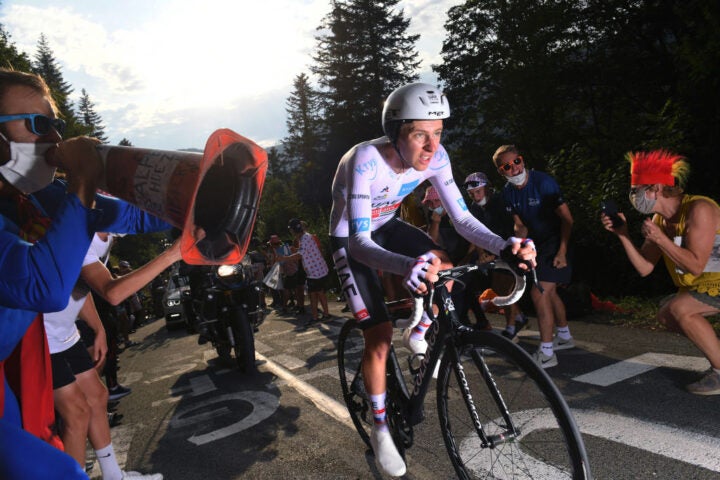
Tech hack: Junior gearing and a director’s call
The moment that won Tadej Pogačar the 2020 Tour de France wasn’t just about legs, it was also about a key choice on gearing.
And more precisely, how fast he was spinning them.
Much has been made about what Primož Roglič went wrong in the final time trial up La Planche des Belles Filles on the penultimate stage of the 2020 Tour. A botched pacing plan, a skewed helmet, moments of panic.
But it wasn’t just Roglič losing the Tour, but as much as a case of Pogačar winning it.
⏱️ Tadej Pogacar won the Tour de France today after setting a new climbing record on Plance des Belles Filles: 16 min 10 sec! The bike change is included in that time, so he could have been ~15 sec faster. ~6,9 w/kg! ALIEN PERFORMANCE! #TdF2020 https://t.co/OHiBrChJuv pic.twitter.com/p0rSrmvJYj
— Mihai Simion (@faustocoppi60) September 19, 2020
His secret weapon? A junior-sized cassette, suggested by then-UAE sports director Allan Peiper, gave him higher cadence and better control on the brutal gradients.
Instead of opting for standard WorldTour gear ratios, Pogačar ran a setup with a smaller rear cassette, the kind typically reserved for under-18 racers.
Peiper said it gave Pogačar more fluid spinning on the brutal climb, with less space between each tooth, allowing him to maintain power and a higher cadence coming out the corners.
Pogačar was still in the “promising stage” of his career, and everyone expected Roglič to hold on for Slovenia’s first yellow jersey.
But it was Peiper’s subtle tweak on the gearing that gave Pogačar the tool he needed to knock Roglič off his rhythm and overturn a 57-second deficit to win the stage and win the yellow jersey by 59 seconds.
Some call it one of the best come-from-behind wins in Tour history. Scroll lower to read about the best.
4. Hinault and the clipless pedal breakout – 1985
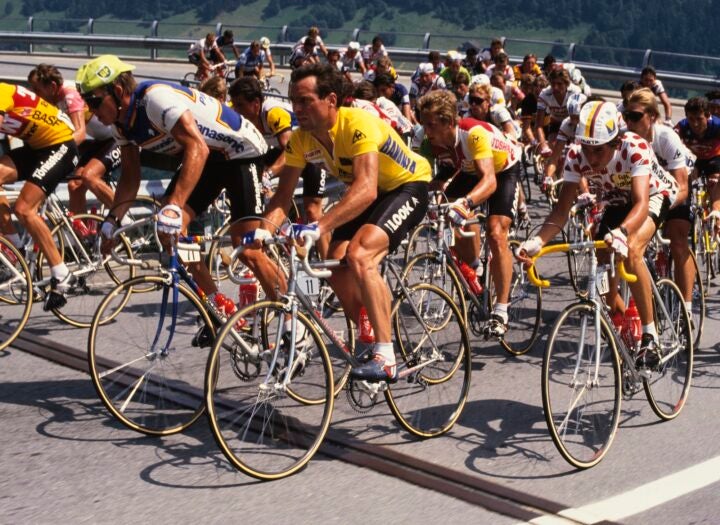
Tech hack: Look clipless pedals
Before 1985, clipping into your pedals meant jamming your feet into toe clips, tightening a leather strap, and praying your foot didn’t slip out when you opened up your sprint.
That changed dramatically in 1985, when Bernard Hinault rocked up with cycling’s first game-changing clipless pedal.
In what was essentially a ski binding on a bike, the Look-designed and built clip-in pedal was one of the revolutionary moments that forever changed cycling.
Bernard Hinault a aujourd’hui 68 ans. Bon anniversaire au plus grand champion que la France ait jamais eu. pic.twitter.com/QxI3O65bhL
— David Guénel (@davidguenel) November 14, 2022
Hinault — the legendary five-time Tour winner and peloton hardman — became the first Tour champion to win with them.
The advantages were quick to see, with efficiency, power transfer, and freedom of movement. Was it decisive in his fifth and final win? That’s hard to say, but after “the Badger” adopted the new tech, the rest of the peloton quickly caught up.
By the next season, everyone from Fignon to Kelly was clipped in, and toe clips soon became as rare as leather helmets, wool jerseys, and tubular tires.
The clipless heralded the arrival of a new wave of materials, bike frames, wheelsets, and components that continue to reshape the peloton.
3. Team Sky and the era of marginal gains – 2012 to 2019
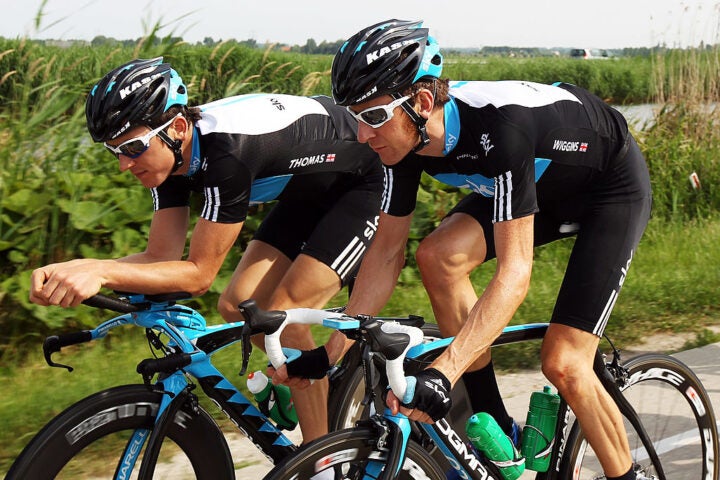
Tech hack: Rewiring everything from nutrition to altitude camps, and custom skinsuits to pillows
Team Sky’s dominance wasn’t won on any single day. In fact, the UK outfit stumbled out of the gates in its first few seasons, but by 2012, it was suddenly the king of the Tour de France.
Its historical run included four different winners and seven yellow jerseys in eight years, and was built on an incremental layering of technology that emphasized the granular to make race-shifting changes.
Sky didn’t invent the idea of looking for tech hacks to improve performance, but it helped revolutionize modern cycling.
Team boss Dave Brailsford and his brain trust disassembled some of cycling’s long-running truths (and myths), and reassembled everything from training, nutrition, recovery, and performance.
Power meters and number-crunching redefined tactics and racing strategy.
The famous Sky Train and “Fortress Froome” were built by charting out every single climb in the Tour de France route, running it through a computer spreadsheet, and then racing to power rather than reacting to rivals.
It might not have been exciting racing, but it was extremely efficient.
Chris Froome vs Tadej Pogačar W/KG graph (excluded ITT). A little bit surprised that Froome performed better on shorter climbs (Mende 2018, 09:15min, 7,31w/kg and Pena Cabarga 2016 16:58min 6,87w/kg). Pogačar is better on 20-50 min climbs. Data: @NaichacaCycling pic.twitter.com/CcWTA4uxGb
— Cycling Graphs (@CyclingGraphs) November 14, 2021
Behind the scenes, Sky took things to another level. The team tweaked and improved some of cycling’s sacred cows, and customized skinsuits, tweaked aerodynamics, updated heat protocols and altitude chambers, and modernized nutrition.
Recovery was a key signature, along with slammed stems and the banned “Richie Mobile.” Even sleeping on team-issued mattresses was part of the marginal gains madness.
It was all in the name of squeezing percentages on every variable of performance.
This was when cycling transitioned from a sport built on long-sworn traditions to F1-like precision and science. Bradley Wiggins, Chris Froome, Geraint Thomas and Egan Bernal all rode to yellow using the same blueprint.
Sky and then Ineos Grenadiers held an edge for nearly a decade, but now everyone has caught up — and even surpassed — the once-mighty innovators.
2. Schleck’s chain-gate meltdown – 2010
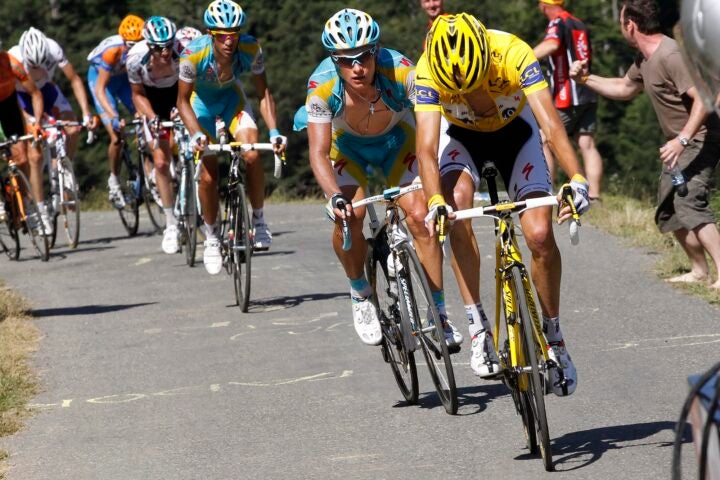
Tech defect: Drivetrain failure under pressure
You can have all the form in the world, but if your machine betrays you at the wrong moment, it can be lights out.
Just ask Andy Schleck. In 2010, he looked unstoppable. With the yellow jersey on his shoulders and full gas up the Port de Balès in stage 15, Schleck launched an attack, only to have his chain slip as he opened up his move.
Behind him, Alberto Contador pounced and never looked back.
Schleck was forced to get off the bike and make a messy bike swap. By then, Contador was gone on the high-speed descent to the finish line, and so was the yellow jersey.
It was one of the most infamous mechanicals in Tour history, not just because it cost Schleck the race, but because it raised the eternal question that now comes up just about every time a yellow jersey faces distress of any kind: should Contador have waited?
MOMENTOS
1. El “chain-gate” (2010)
Andy Schleck atacó en el Port de Balés en busca de ampliar su ventaja en la general, pero se le salió la cadena. Contador se aprovechó y se puso líder.
Una regla no escrita dejó sin Tour a Andy, pero más tarde otra sí escrita se lo devolvió. pic.twitter.com/8h3losnI43
— David García Landero (@DavidGL97) December 31, 2019
The Spaniard didn’t, and the 39 seconds he gained that day turned out to be the exact final winning margin in Paris.
Some blamed Schleck for poor shifting technique because he was on his big chainring and shifting into the smallest gear on his rear derailleur, which caused the chain to slip.
Schleck’s misfire didn’t last long.
Contador later tested positive for clenbuterol — a banned steroid that he said he picked up while dining on contaminated Spanish steaks — but CAS disagreed and he was stripped of the Tour crown in 2012. Schleck retrospectively was awarded yellow.
1. LeMond’s aero TT revolution– 1989
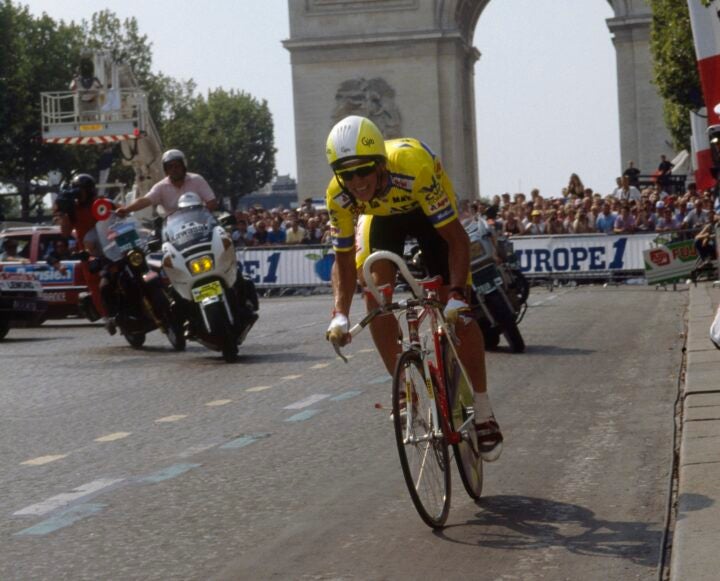
Tech hack: Tri-bars, aero helmet, disc wheels
The 1989 Tour de France will live forever.
In perhaps the Tour’s most famous ending, Greg LeMond overturned a 50-second deficit on the Champs-Élysées to win the Tour by what remains the smallest winning margin in the history of the men’s race.
Some traditionalists laughed when he showed up using a time trial using a setup that included triathlon bars, an aero helmet, and disc wheels. Some 24.5km later, Tour history was made.
French legend Laurent Fignon, resplendent in his ponytail and round specs, went old-school and ended the stage in tears.
LeMond averaged over 54kph and clawed back every second and then some, winning the Tour by just eight seconds. The photos of LeMond celebrating with joy and Fignon collapsing on the ground were beamed around the world.
After his defeat to Lemond at the 1989 Tour de France Laurent Fignon used the time trial bars to good effect a few months later during the GP des Nations, winning the race and also breaking the course record.
Offside pic.twitter.com/bA5DU0vczn
— cycling archives (@mission753) June 6, 2025
